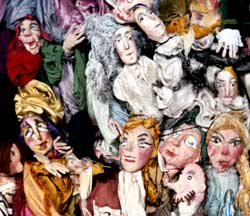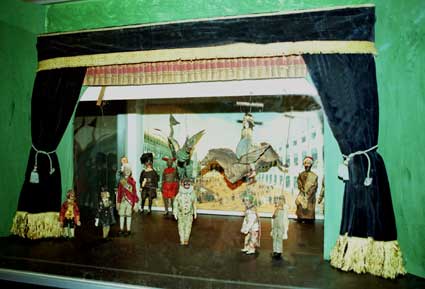
 Collezione
Maria Signorelli
Collezione
Maria Signorelli
Italian marionettes of the eighteenth century
The
Puppets of Maria Signorelli
The fairy tales, nursery rhymes and films
Shows with classical and modern texts, films
The ballets of Maria Signorelli
19th-20th century Italian rod and glove puppets
19th-20th century Italian marionettes
20th century foreign rod and string puppets
Sicilian, Pugliese and Neapolitan puppets
Toy
rod, glove and string puppets
Paper
and card theatres, sets and characters
Scripts
of puppet and marionette plays
Posters
of puppet theatre productions and festivals
In the eighteenth century, a century rich in theatre, the marionette created extraordinary interest. Unlike the rod puppet, which was of lower-class origin, it was widespread in aristocratic circles, answering, among other things, to the architectural taste of the period: the theatre in miniature allowed surprising effects to be achieved, as also artful and complex constructions, to create fairy tale worlds within structures which, skilfully and perfectly calibrated, were in themselves a celebration of the Age of Enlightenment.
In Italy, particularly in Venice, the marionette enjoyed enormous popularity, as Goldoni’s memoirs also attest.
In the collection there are thirty eighteenth-century puppets, some of them from Venice, such as the group of Arlecchino, the Player, and Brighella, 30cm high, belonging to the Corà family. The Player and Brighella are made with wooden bust and thighs, hands and legs of lead, and arms of rope: they correspond in construction technique to some seventeenth-century marionettes. The Arlecchino, however, is entirely of wood.
Also noteworthy is the Venetian couple of Lady and Cavalier, wooden marionettes with silk costumes of the period, trimmings of gold and silver, and wigs. The marionette of a Cavalier richly clothed and with tin shield, astride a cardboard hippogriff, is very striking; equally so the Flying Dragon 60cm long, whose body of green cloth is made supple by a metallic coil running right through it.
All the marionettes belonging to this collection, as was to be expected from the type of aristocratic theatre to which they belonged, are constructed with great richness of detail, and each of them in fact deserves detailed description.
